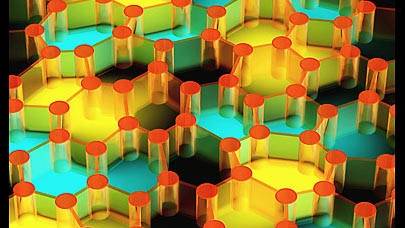Big Bang Theory: Artist Among Scientists
Source: youtu.be
Big Bang theory : "The sky is the limit for some artists: and for the physicists the world as we know it is often not enough. So who is more spaced out? The artist or the scientist? At Cern on the outskirts of Geneva, the first artist in residence at the world’s largest particle physics laboratory has helped smash culture and science together"Analysis: Elizabeth Leafloor | RedIceCreations.com
This interesting short video by SwissInfo examines intriguing concepts that are rarely discussed: What role does art and differences in mind and perception play in science? How are art and science related? Can one be artistic as well as scientific? Who PAYS for these programs?....
On its face, this is a great idea: lump a typically eccentric and enigmatic artist in with the straight-laced and stereotypical serious scientific minds, and let the wacky times roll! Reality TV may have met its match.
Broadening perspectives, Opening Minds, Whipping A Duck Pond
It would have been good to have seen how the scientists on the floor (who AREN’T spokespeople for the project) reacted to the artist’s concepts; Personal interviews on the effect on their thought processes, changes in their work, unexpected inspirations, or complaints about being distracted from ’real’ work.
The resident artist, Julius von Bismark, makes insightful observations about the modern dynamic of scientific study:
"Nothing is more true than science" and,
"It’s a reality factory."
Both concepts are accurate in their own way. These days science is touted as the highest form of truth, outstripping anything religion has to say about the mysteries of the universe or the nature of man on earth. Attempt to go against the popularly understood truths of science with observations that are not accepted by the entrenched community, and you can be labelled an ignoramus or heretic, depending on the issue.
’Science’ is a huge industry and can often be likened to a factory, churning out lines of thinking and dogmatic verse for the science writers to sell in pretty packaging and for the end consumer to swallow.
And perhaps that is where art (and human consciousness) must play a role to temper the dominating and crushing power of scientific "consensus".
But as demonstrated in the video, in almost MontyPythonesque fashion, the artist seems to side with ’science’ when it comes to rationale.
Nature is Not Inherently Good
To challenge our preconceptions that nature is always good (and he makes a valid point, although one could say nature is a ’neutral’, rather than a bad thing requiring punishment) Bismarck whips up mountains and duck ponds in order to demonstrate his argument. Are the CERN scientists challenged by these displays, or are they laughing?
Is this how science sees the natural world? Something so inherently confounding, nonconforming and challenging that it needs to be punished? Whipped into shape? Made to comply with the elaborate and expensive tests and experiments they set up, such as at CERN?
But science and nature do not need to be at opposite ends of a spectrum. What is more organic than human observation of the world around us? What is more natural than studying ourselves, where we live, our universe, and all the parts within and without?
We have always employed tools to create, be they pigments on palms, or later paintbrushes, instruments to make music, or even now smart-phones to record ourselves and others doing artistic things? Science and technology all played the essential role in our development of artistic expression.
Contrary to how the video portrays the situation, and how society largely sees it, art and science have never been separate. They are two tiny bits of a wonderful and varied cacophony of thought and creativity. While it’s good to be reminded of the connection in projects such as this, the so-called "Laboratory Masterminds" have not brought together two disparate ideas - they have simply gathered players onto a stage to pantomime the already inherent connection.
And that’s probably a good thing. It challenges and reminds us all that through artistic endeavor and scientific examination (and open thinking), we are inching our way closer to understanding the universal experience by creating it.
Now if you’ll excuse me, there are some evil trees outside that need a good hug.
By Elizabeth Leafloor, RedIceCreations.com

Experiments in BeautySource: TIME.com
Each spring, the "Art of Science" competition at Princeton University rewards three university scientists for their contributions — not to science, but to art. The dozens of submissions, created during the course of scientific research, can sometimes be surprisingly revealing, and the images represent fields as varied as astrophysics, fluid dynamics, genomics and zoology. (The image above is a close-up of a new "photonic solid" invented by Princeton physicists; think of it as a semiconductor of light, rather than electricity.)
The Art in Science: Visualising earth’s tides
NASA’s Scientific VIsualisation Studio produced this video demonstrating how the earths tides ebb and flow around the world. It doesn’t include narration or annotation because, they explain, ’The goal was to use ocean flow data to create a simple, visceral experience’.Source
"Up top you’ll find some downright gorgeous footage of a coronal mass ejection (a roiling whip of plasma, hurled from an active region on the Sun). It was shot by NASA’s Solar Dynamics Observatory during an intense solar storm on August 31."
Tune into Red Ice Radio:
Ben Stewart - Cymatics, The Shadow, Language & DNA
Michael S. Schneider - Constructing The Universe with 1 through 12, Nature’s Numerical and Geometric Language
Paul Levy - Synchronicity, Dreams & Art
Neil Hague - The Rise of the True Human Being, Art & Unlocking the Imagination
Steve Willner - CERN, Movies & Symbolism
Holger Bech Nielsen - CERN & the Large Hadron Collider ’Being Sabotaged from the Future’
Dan Winter - Fractal Geometry & The Golden Mean






















